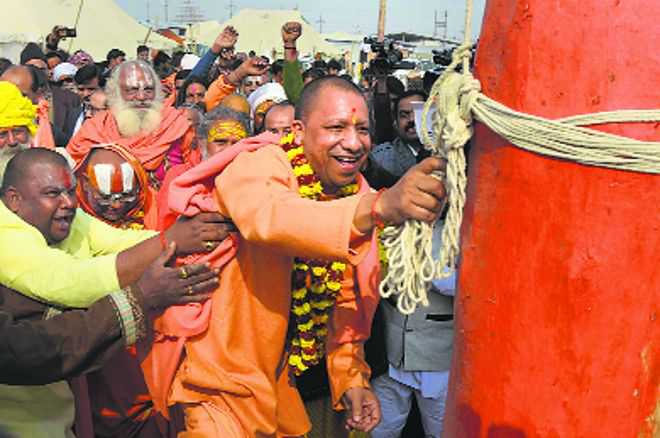
Arbitrary: As the CM’s writ runs only in UP, the pan-Indian description would be fragmented, with Prayag following a different nomenclature for its Kumbh than the other locations.
Rajesh Kochhar
Honorary Professor, Maths Dept, Panjab University
BEGINNING with Makar Sankranti (January 15), Prayag (Allahabad) will celebrate Ardh Kumbh on a gigantic scale. The Uttar Pradesh Government, led by Chief Minister Yogi Adityanath, has unnecessarily changed the traditional nomenclature and designated the event as Kumbh. It is ironical that while so much time, money and energy are being expended for the sake of tradition, long-established nomenclature is being changed on a whim.
The Kumbh Mela has been included by UNESCO on its representative list of Intangible Cultural Heritage of Humanity, noting that it is the largest peaceful congregation of pilgrims on earth. The mela is celebrated at four sites on the banks of rivers: Haridwar, Ujjain, Nashik-Trimbak, and Prayag. Every 12 years, the event is celebrated as Purna Kumbh. Half way through it, every six years, Ardh Kumbh is celebrated. Prayag also holds Maha Kumbh after 12 cycles of Purna Kumbh — every 144 years.
Kumbh was celebrated at Trimbak (Nashik) in 2015 and at Ujjain in 2016. Ardh Kumbh was held in Haridwar in 2016. Prayag celebrated Kumbh in 2013 and is holding Ardh Kumbh this year.
The choice of the venues is sought to be explained through a Puranic story known as samudra manthan (ocean-churning). To prevent the pot of amrit (nectar) obtained through churning from falling into the hands of asuras, it was carried from place to place by the devas. In the process, drops fell at four places, which in turn became the Kumbh Mela sites. While the standard story does talk of the pot of nectar from the ocean, its linkage to the mela seems to be an afterthought. In any case, the story does not explain the timing.
The timing is fixed astronomically. The celebrations are in honour of Jupiter, which has an orbital period of about 12 years. For the event to occur, Jupiter should be in a specified zodiacal sign (rashi).
Jupiter spends a year in one rashi, but the celebrations do not last that long. To narrow down the time span, help is taken from the sun and the moon. To describe the path of the sun, the zodiacal list is headed by Aries (Mesh). For some reason, in the case of Jupiter, the most important rashi is Aquarius (Kumbh). While Aquarius is depicted as the water-man, its Indian equivalent is the water pot.
The term Kumbh has come to be used in two distinct senses: to denote the rashi proper and as a general description for the congregation. Strictly speaking, there is only one Kumbh, namely the one at Haridwar, when Jupiter is actually in Aquarius (and the sun in Aries).
The congregations at Nashik and Ujjain are not Kumbh but Simhasth because in both cases Jupiter is in Leo (Simha). That is why the two events are never more than a year apart. Simha rashi is important because it falls midway in Jupiter’s 12-year orbit from Aquarius to Aquarius. The Ujjain event takes place when the sun is in Aries while Nasik waits for the sun to keep company with Jupiter in Leo.
The official website of Prayag Kumbh 2019 states, without quoting any source: “Lord Brahma performed yajna here for creating the universe.” Even though the Prayag Kumbh Mela is the largest and most famous, it is probably the youngest. While the other three events are named after Jupiter’s actual position in the sky (in Aquarius or Leo), the Prayag event is named after Kumbh in the sense of a congregation. The tradition of an annual Maghi Mela on the occasion of Makar Sankranti appears to be very old. At some stage, a bigger 12-yearly event came to be celebrated on Makar Sankranti when Jupiter is in Mesh or the following rashi, Vrishabh (Taurus).
While releasing the logo for the Prayag-2019 event, Yogi Adityanath facetiously asserted that since there was nothing incomplete in Hinduism, Ardh Kumbh would be designated as Kumbh, and the Kumbh as Maha Kumbh. His argument would have carried weight if the name Ardh Kumbh had been given by non-Hindus!
There is nothing incomplete or vague about the mathematical fact that six is half (ardh) of 12. In Yogi Adityanath’s scheme of things, no unique term is now left to denote the event held every 144 years.
Also, since the order cannot be implemented retrospectively, it will create confusion between the description of past and present congregations at Prayag. Thus, a Kumbh was celebrated in 2001 and 2013 and is again being held in 2019. Finally, since the Chief Minister’s writ runs only in UP, the pan-Indian description would be fragmented, with Prayag following a different nomenclature for its Kumbh than the three other locations.
As a matter of policy, a government should desist from unilateral action on matters involving tradition, culture and religion. There are indeed calendar matters that would benefit from government interest. Because of differences among traditional astronomers, Kumbh was celebrated in Prayag in 1965 as well as 1966. The UP Government should call a meeting of traditional panchang makers, Sanskrit scholars and modern astronomers to find out why this happened and to ensure that there is unanimity on the timing of the Kumbh.
All over India, Makar Sankranti is nominally celebrated as Uttarayan (northward turning of the sun) or winter solstice, even though it has already taken place around December 21. Because of errors in the Vikrami calendar, Makar Sankranti keeps moving to later dates. There is a need to reform the traditional calendars to bring the ‘calculated’ sky in consonance with the observed sky.



























